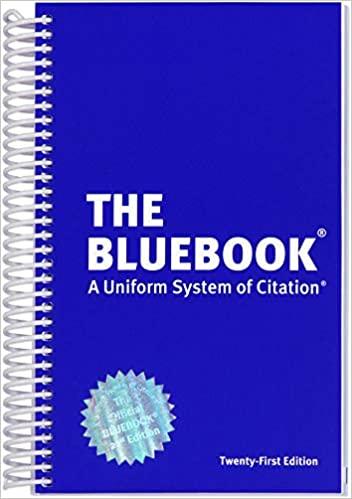Question
Goals Take stock of your legal problem-solving skills, particularly as they apply to statutes and precedents in order toapply them to a simplified scenario. Focus
Goals
- Take stock of your legal problem-solving skills, particularly as they apply to statutes and precedents in order toapply them to a simplified scenario.
- Focus on the interplay between rules - general statements that are forward-looking, and precedents - application of rules to specific situations that are backward looking.
- Consider the need for flexibility in the application and interpretation of legal and legalistic rules.
- While we have been learning about the technical skills of legal advocacy, maintain a focus on the role of professional ethics in the service of client interests as the reason for these processes.
Core Task
This is a hypothetical example of a pseudo-legal process that integrates rules and precedents but excludes the need for legal research.The first part combines the forms of analysis that you have studied in this unit.The second raises the question of ethics in representing a client's best interests.
Part A: Litigating Pet Court
Jude and Davis share a house with seven non-humans, Esme (a dog), Cocteau and Manji
(both cats) and four rats (Zim, Daggett, Mr Mills & Lumpkin). The dog spends the day in
the yard and the night in the house. The cats spend all their time in the house and are not
permitted outside. The rats live in a cage.
Being an unusual couple, Jude and Davis conduct a session of "Pet Court" each week where
the pets are brought to account for their recent misdeeds. This has become a YouTube hit and you have been asked to appear as a lawyer for the pets.
The Pet Rules
- Pets shall always obey humans
- Pets shall do everything in their power to protect the house and the property of humans
- Pets shall not steal from humans nor harm the property of humans (including food)
- Pets are not allowed on the furniture
- Pets will not make puddles in the house, nor make unpleasant smells
Punishments available to the Pet Court
- Severe scolding
- Corporal punishment - the rolled up newspaper
- Banishment to the yard outside
- Being sent to the pound - the ultimate threat.Jude does threaten sending them to the cosmetics lab on occasion, but this is believed to be a joke.
Precedents
- Davis sneaks snacks to the pets if they beg cutely. This happens with the leftovers after most meals.
- When there is no proof of who broke the rules, the dog gets blamed by default.
- The cats are allowed on the furniture, notwithstanding the prohibition in the rules. The dog is not allowed on the furniture generally but is allowed to sleep on the foot of the bed.
- The rats have escaped from their cage several times but they are not held accountable for the damage they do as, according to Jude, they "cannot help what they do". Likewise rats are not expected to use pet litter like the cats or the yard like the dog.
- Once Esme knocked over a hideous vase accidentally due to vigorous tail wagging. As the vase was a disliked present from Jude's grandmother, Esme was excused, even though the water from the vase damaged the rug.
The Indictments
1. On Tuesday night both humans were out of the house. A burglar attempted to enter thehouse but was scared off by Esme. In the course of these duties, the dog knocked over a vase and left wet paw prints on the lounge.
2. On Monday while both humans were at work, someone made a puddle (possibly urine) onthe new rug. On this day the dog was left inside by accident and has been blamed.
3. Manji has been stealing scraps of leftover food off of plates in the kitchen. This cat hasalso dropped scraps on the floor for Cocteau (who has three legs and cannot jump up to thebench). This practice has been going on for a while with no proof of who was responsible, but on Wednesday, Manji was caught.
Respond to each of the indictments.Do not worry too much about legal correctness or procedure.
Part B: Ethics and Advocacy
what are the responsibilities that you had toward your clients in this situation?As animals they definitely do not expect the same standards of advocacy as normal legal cases, but you should still be able to identify the core principles.
Reflective Seeds
- This was a simple, somewhat frivolous example. In what ways do you think real legal scenarios are more complicated?
- Role of rhetoric and principles in creating arguments.Did you find that your were adopting a certain kind of legal persona when making the arguments (eg a 'law and order' lawyer or a civil rights advocate?).
- What is most useful to you in making a decision, firm principles (rules) or examples of how they might be applied (precedents)?Where does the legal approach fit in'wiggle room' for discretion?How is the need for flexibility balanced against the need for formal legal authority?
Step by Step Solution
There are 3 Steps involved in it
Step: 1

Get Instant Access to Expert-Tailored Solutions
See step-by-step solutions with expert insights and AI powered tools for academic success
Step: 2

Step: 3

Ace Your Homework with AI
Get the answers you need in no time with our AI-driven, step-by-step assistance
Get Started


